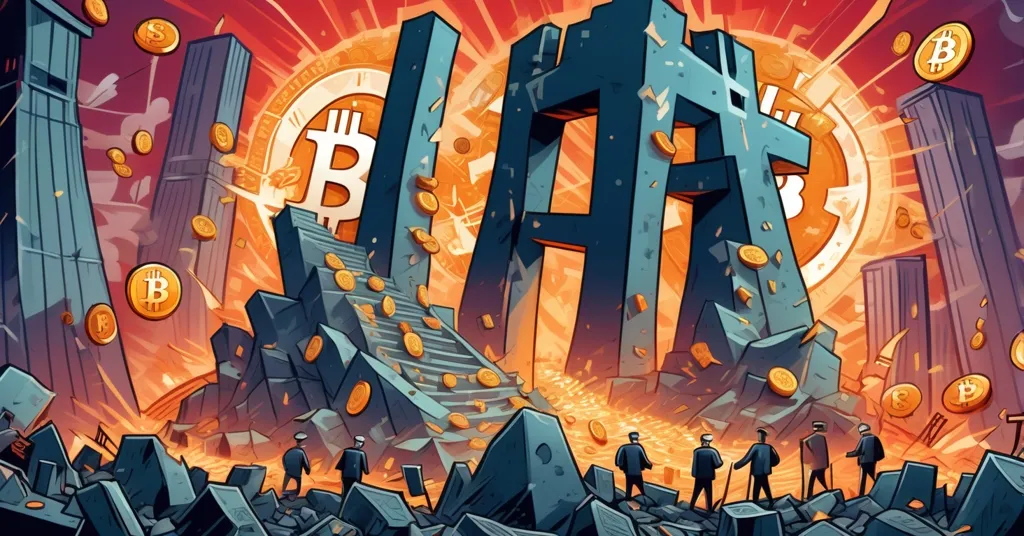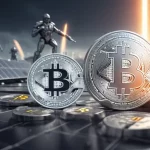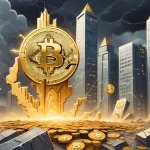Trump’s Tariffs: Inflation Dodge or Economic Disaster for Bitcoin’s Rise?

Trump’s Tariffs and Inflation: Patriotism or Smokescreen? Unpacking Hassett’s Claims
White House economic advisor Kevin Hassett has dropped a bombshell claim: President Donald Trump’s hardline tariff policies aren’t jacking up inflation, and the reason might just be a wave of American patriotism pushing consumers to buy domestic. But as the trade war heats up with new tariffs on the horizon, critics are slamming this narrative with hard data, while economic uncertainty brews a storm that could make Bitcoin and decentralized finance more relevant than ever.
- Inflation Defied? Hassett insists tariffs haven’t spiked prices, citing a drop in import costs from December to May.
- Patriotic Push? He credits a “buy American” surge for curbing demand for foreign goods.
- Reality Check: Economists counter with evidence of rising import prices since March, warning of delayed inflation risks.
Hassett’s Case: Tariffs Without the Price Pain
Trump’s tariff strategy has been a cornerstone of his economic playbook, aiming to shield U.S. industries by slapping taxes on imported goods from countries like China, Mexico, and Canada. Typically, tariffs work like an extra checkout fee on foreign products—think of it as a surcharge on that imported smartphone or car part. The logic goes that higher costs for foreign goods should drive up prices for American consumers, fueling inflation, or push shoppers toward domestic alternatives. Yet, speaking on CNBC’s Squawk Box, Hassett argues that this expected price surge hasn’t hit. He points to a decline in import prices—a measure of the average cost of goods entering the U.S.—between December and May, even as new tariffs were rolled out. For a deeper look into his perspective, check out this analysis of Hassett’s argument on tariffs and inflation.
“There’s, I think, a lot of patriotism in the data,”
Hassett proclaimed, suggesting Americans are ditching imports for homegrown products. He reinforced this with:
“The bottom line is, people prefer American products,”
claiming this shift has tanked demand for foreign goods so much that prices have dropped despite the tariffs. He also argues that countries with trade deficits like Mexico, China, and Canada are eating the tariff costs rather than passing them on to U.S. consumers, painting a picture of a trade war where America comes out unscathed. With new 30% tariffs on the European Union and Mexico set to kick in on August 1, 2025, Hassett’s optimism is a bold defense of Trump’s aggressive stance. See how markets reacted to these latest threats in this update on tariff announcements and market trends.
Critics Hit Back: Data Doesn’t Wave the Flag
Before we start chanting “USA” at the grocery store, let’s get real. Yale economist Ernest Tedeschi, who previously served on the White House Council of Economic Advisers under a different administration, isn’t buying Hassett’s red, white, and blue smokescreen. Drawing on data from Harvard University’s Pricing Lab, Tedeschi reveals that import prices have been climbing since March 2025, directly contradicting Hassett’s cherry-picked timeline. He’s blunt about the White House’s spin, as detailed in this critique of Hassett’s claims on import price trends.
“Will understate tariff effects in their import indices,”
he warned, suggesting their methodology glosses over the real impact. Other experts point to a less patriotic explanation: stockpiling. Importers, foreseeing tariff hikes, likely bulked up on goods before the taxes hit, creating a temporary buffer against price jumps. Data backs this up—reports show significant pre-tariff import surges in sectors like steel and electronics, delaying inflation but not dodging it forever. Think of it as hoarding canned goods before a storm; eventually, the shelves run dry, and you’re stuck paying premium for what’s left.
Looking at specific industries, tariffs on steel and aluminum—key inputs for everything from cars to construction—have already nudged costs up for manufacturers, even if consumer prices haven’t fully reflected it yet. For instance, the price of raw steel imports rose by roughly 8% between March and June 2025, per trade data, a slow bleed that could hit wallets harder as stockpiles dwindle. Consumer electronics, heavily reliant on Chinese components, are another ticking time bomb, with early signs of price creep on items like smartphones and laptops. Hassett’s claim might hold water for now, but the cracks are showing. For a broader historical context, explore this overview of Trump’s tariff policies and their economic impact have already nudged costs up for manufacturers, even if consumer prices haven’t fully reflected it yet. For instance, the price of raw steel imports rose by roughly 8% between March and June 2025, per trade data, a slow bleed that could hit wallets harder as stockpiles dwindle. Consumer electronics, heavily reliant on Chinese components, are another ticking time bomb, with early signs of price creep on items like smartphones and laptops. Hassett’s claim might hold water for now, but the cracks are showing.
Broader Economic Tremors: Recession on the Horizon?
Zooming out, the tariff saga is just one piece of a wobbly economic puzzle. Trump’s latest tariff threats haven’t spooked markets as much as expected—on the announcement day, the Dow Jones Industrial Average crept up 28 points (0.1%), with the S&P 500 and Nasdaq Composite gaining 0.1% and 0.4%, respectively. This calm might stem from investor bets on negotiations softening the blow, especially since Trump has signaled openness to trade talks. But don’t mistake stability for strength. The Economic Policy Uncertainty Index, a gauge of policy unpredictability, has spiked to its highest level since the pandemic, driven by Trump’s erratic moves, as noted in this report on economic uncertainty surrounding Trump’s policies. Consumer confidence, measured by the University of Michigan’s index, has plummeted nearly 16% year-over-year as of February 2025, a red flag since consumer spending fuels 70% of U.S. GDP. Worse, the Atlanta Fed’s GDPNow forecast—a real-time snapshot of economic growth—predicts a brutal -2.4% contraction for Q1 2025, hinting at recessionary winds.
Historically, such drops in consumer sentiment and policy uncertainty have preceded downturns—think the 2008 crash or even the early 1980s stagflation mess. Gerald Cohen from the Kenan Institute warns that this uncertainty could freeze critical business decisions, potentially tipping the economy over the edge. Meanwhile, countries like China and the EU aren’t sitting idle; retaliatory tariffs on U.S. goods like agriculture and tech are already squeezing exporters, and currency adjustments in response to trade tensions could boomerang back, devaluing the dollar and stoking inflation anyway. Hassett might shrug off price hikes, but the broader economic battlefield looks uglier by the day. Community discussions on platforms like Reddit offer varied perspectives on tariff effects on inflation.
Fed Under Fire: A Dangerous Power Play
As if trade wars weren’t enough, Trump’s administration is picking a fight with another pillar of economic stability: the Federal Reserve. Hassett didn’t mince words on ABC News, hinting at drastic action, as explored in this analysis of Hassett’s tariff-related statements:
“Trump can fire Federal Reserve Chair Jerome Powell if there’s cause,”
while White House officials are reportedly digging into renovation costs at the Fed’s D.C. headquarters, possibly hunting for leverage. This isn’t just posturing—it’s a direct threat to the Fed’s independence, a cornerstone of stable monetary policy. Meddling here risks tanking market trust faster than a bad crypto rug pull. If the Fed bends under pressure, interest rate missteps could amplify inflation or choke growth, making tariffs look like small potatoes. Experts like Emily Gee from the Center for American Progress argue this erratic policy-making inflicts real damage, disrupting both public agencies and private sector planning. It’s centralized chaos at its worst, and it’s why many are eyeing alternatives outside the system.
Bitcoin and Decentralized Finance: A Hedge in the Chaos?
This brings us to the crypto angle. Tariffs, inflation risks, and government overreach are the exact kind of centralized failures that Bitcoin was built to challenge. As a Bitcoin maximalist at heart, I see it as digital gold—an unassailable store of value when fiat currencies wobble under policy blunders or dollar devaluation. If consumer confidence keeps tanking or recession hits, Bitcoin’s appeal as an inflation hedge could soar, especially as trust in traditional systems erodes. Look at past spikes: during the 2020 pandemic uncertainty, Bitcoin rallied over 300% as central banks printed money like there was no tomorrow. Trump’s tariffs and Fed meddling could trigger a similar distrust in fiat, pushing more folks toward decentralized alternatives. For insights on this trend, see this piece on Bitcoin as a hedge during trade war volatility.
But I’m not here to shill blind optimism. Bitcoin isn’t a cure-all—its volatility can gut portfolios faster than a trade war tweetstorm, and regulatory crackdowns loom as governments scramble to control economic fallout. Beyond Bitcoin, other blockchains like Ethereum offer unique tools; think smart contract platforms enabling transparent supply chain solutions (like VeChain) to bypass tariff-laden trade routes, or stablecoins for cross-border payments dodging currency fluctuations. Yet, scalability issues and adoption hurdles mean these aren’t ready to replace fiat overnight. Crypto’s a promising escape hatch, but it’s still a wild west—don’t bet the farm just because Hassett’s data smells fishy.
Cutting Through the Noise
Let’s call a spade a spade: Hassett’s patriotism pitch is a flimsy distraction from gritty economic realities. The data—rising import prices since March, stockpiling buffers running thin, and a GDP forecast screaming recession—paints a far messier picture than his flag-waving spin suggests. Trump’s tariff gambit might aim to boost domestic industry, and I’m all for smashing globalist trade norms, but pretending there’s no risk of long-term price hikes or economic downturn is reckless at best, delusional at worst. Toss in the Fed power play, and you’ve got a recipe for centralized disaster that could screw markets harder than any meme coin crash. For additional user-driven insights, check out this discussion on how Trump’s tariffs might influence inflation.
For crypto enthusiasts, this mess is a glaring reminder of why decentralization matters. When government policies go off the rails, having a lifeline like Bitcoin or Ethereum-based solutions isn’t just nice—it’s survival. But let’s keep our heads on straight; crypto isn’t immune to volatility or crackdowns, and overhyping it as a silver bullet is as bad as Hassett’s rosy tariff tale. As tariffs test the limits of centralized control, will decentralized systems step up as true alternatives, or are we banking too much on tech that’s not battle-ready for a full-blown crisis? Chew on the evidence and figure out where you stand—this trade war’s far from over, and the stakes are only getting higher.
Key Questions and Takeaways
- Are Trump’s tariffs really not causing inflation, as Hassett claims?
Not quite—while import prices dropped from December to May, data shows a rise since March 2025, hinting that inflation might just be delayed, not dodged, due to stockpiling. - Is American patriotism truly driving lower import demand?
It’s a nice story, but there’s no solid evidence like consumer surveys or retail data to back up a mass shift to domestic goods as the main factor. - What are the deeper economic risks tied to these tariffs?
Beyond delayed inflation, policy uncertainty, falling consumer confidence (down 16% year-over-year), and a projected GDP contraction (-2.4% for Q1 2025) signal potential recession. - How could Bitcoin and crypto respond to this economic uncertainty?
Bitcoin could shine as an inflation hedge if fiat trust falters, while platforms like Ethereum might offer trade and payment solutions, though volatility and regulatory risks remain. - Is Trump’s pressure on the Federal Reserve a bigger threat than tariffs?
Quite possibly—undermining the Fed’s independence could destabilize monetary policy, risking market chaos that overshadows tariff-driven price hikes.



